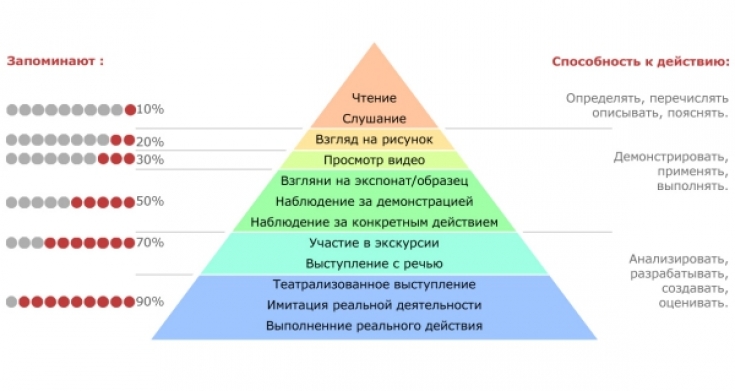Can't learn English, a new computer program, or anything else important? This is often due to a decrease in the level of concentration, fatigue and absent-mindedness.
This needs to be dealt with. But how? Exit one – choose the right methodology for learning and development.
The best option is the "cone of experience" Edgar Dale. It clearly shows us how effective certain methods of obtaining knowledge are considered.
After thoroughly familiarizing yourself with this technique, you can test it in self-education or apply it in teaching other people. How to increase the effectiveness of your training, the Internet edition estet-portal.com will tell you.
1. Edgar Dale's Cone of Learning and Development: What it is
2. Learning and development: moving from the top of the cone to the bottom
The Edgar Dale Cone of Learning and Development: What it is
In 1969, there was one study that evaluated the effectiveness of various methods of obtaining knowledge.
As a result, the famous professor Edgar Dale created the so-called "cone of experience", based on his own experiments.
This discovery clearly shows 2 things:
• Reading textbooks and listening to lectures – least effective way of learning and development. In this case, information is forgotten in a short period of time or perceived and assimilated with tremendous effort.
• Practical application of acquired knowledge and teaching others – the most efficient way to absorb any information.
Edgar Dale's cone clearly shows that it is impossible to learn something if you do not apply the knowledge gained in practice. It is necessary to act at the stage of obtaining this or that information.
"Cone of Experience" consists of a chart of various ways of presenting information, opposite which the percentage of their effectiveness is indicated.
These numbers are approximate, as they were not identified by Professor Dale himself, but by his followers in the course of further study of the methodology learning and development.
You can clearly see them in the following picture.

Learning and development: moving from the top of the cone to the bottom
Now let's take a look at the components of the "cone of experience" Edgar Dale more:
• Reading. People remember 10% of what they read. Therefore, reading books and scientific articles is not accidentally included in the process of learning and development.
• Listening. Listening to audiobooks, a person remembers more than reading paper counterparts. Therefore, while doing household chores, going to work or walking in the park, combine business with pleasure by taking a player with recorded books. And in order to teach something to another person, the best option would be to tell him something useful than to let him read a book. In this way, he will better remember the new information.
• View pictures. Use pictures in addition to text to better understand something new.
Information presented in the form of slides, diagrams or mind maps is stored in the head even better: people remember 30% of the information from what they see.
• Watching a video. A person remembers 50% of what he heard and saw. Therefore, an interesting video lecture will stick in your head better than an article on the same topic. It is no coincidence that training videos are actively "walking" over the internet.
• Comment + demonstration. 70% of the information is absorbed from what the person has said, especially if it is backed up by a demonstration. When talking about something, use exhibits, mock-ups, experiments, and other demonstration methods. Visual images serve as faithful assistants in learning.
• Discussion. This way of teaching is also effective. Therefore, if your goal is to teach someone, arrange a discussion with your student or several students. Ask questions and ask for answers to them, put forward theses and ask to support or challenge them. And if there are students who have different opinions, be sure to let them speak out. Thus, the information is better absorbed.
• Giving a speech. To remember something, tell a wide audience about it. Giving a speech requires careful preparation: you need to plan, work with the material, and rehearse your speech in front of a mirror. But this will help you to best assimilate your knowledge.
• Theatrical performance. 90% of information is acquired from what a person said or wrote down in the course of this or that action. Therefore, theatrical performance will be just right. Prepare a certain topic, approach it creatively and with humor, then perform on stage. This method is especially good if your goal is – teach something to children. After all, for them it will seem like a fun game that will be remembered for a long time.
• Imitation of real activity. This method is similar to the previous one, but it is more realistic. For example, if you simply list the actions that need to be done to produce outerwear, they are unlikely to stick in your head. But if you offer to pretend that people produce things themselves, this information will surely be remembered by them.
Each of these ways of assimilation of information is good in its own way. But if you only teach others and neglect the application of theory in practice, there will be little sense from this.
So be sure to practice all the ways to learn and grow in your life. Try different layers of the cone, change methods or use all methods. And only in this case, good results will not make you wait long.
After absorbing the acquired knowledge and gaining some experience, you may well use all this in different areas of your life.
Developing the Mind: Ways to Train the Brain
You may be interested in: Memory Test.






Add a comment